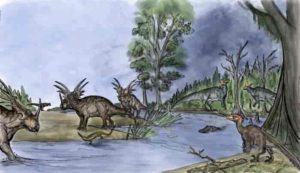
By casting an eye into the daily lives of dinosaurs millions of years in the past, Western researchers may be helping humanity get a glimpse of its future.
Seventy-five-million years ago, North America was divided into western and eastern landmasses by a shallow inland sea. The west was home to an extremely rich diversity of dinosaurs; it has been a mystery as to how so many big animals co-existed in such a small area.
Researchers have proposed that diversity was maintained by dividing up the landscape and food sources. For example, horned dinosaurs (ceratopsians) may have stuck to coastal areas, while duck-billed dinosaurs (hadrosaurs) preferred more inland habitats.
This idea remained untested, however, as researchers cannot directly observe dinosaur behavior and ecosystems.
To solve this conundrum, a team including Western researchers has now compared the compositions of stable isotopes in fossil teeth from these dinosaurs.
Stable isotopes are naturally occurring varieties of chemical elements (like carbon or oxygen) that do not change into other elements over time. When animals consume food and water, the stable isotopes of the elements that make up those resources are passed to the animal’s tissues, including tooth enamel.
The stable carbon and oxygen isotope compositions of these herbivorous dinosaurs were measured using various methods. The primary approach was laser gas chromatography isotope ratio mass spectrometry conducted at Western’s Laboratory for Stable Isotope Science (LSIS) by Anthropology professor Fred Longstaffe, Western research scientist Li Huang and project lead Thomas Cullen of the Field Museum.
“This approach allowed us to analyze very small samples and, because of that, extend the science of isotope ecology back into the time of the dinosaurs,” said Longstaffe, Canada Research Chair in Stable Isotope Science. “Normally, my isotope ecology work is focused on Ice Age animals and the reasons for their disappearance or survival. To attempt to reach back much deeper to the time when the dinosaurs lived was both challenging and exciting.”
The study, “Large-scale stable isotope characterization of a Late Cretaceous dinosaur-dominated ecosystem,” was recently published in the journal Geology.
The researchers compared results for numerous individuals of each dinosaur species to those of other animals in this ancient ecosystem. While multiple ecological patterns are evident in the results, and differences found in some species, the stable carbon and oxygen isotope ranges for large herbivorous dinosaurs were found to strongly overlap, providing direct evidence against the habitat use hypothesis.
“Measuring the ratios of the different isotopes of elements such as carbon or oxygen in tissues like tooth enamel gives us a unique window into the diet and habitat of an animal who has been extinct for millions of years,” Cullen said.
“Dinosaurs lived in a weird world: broad-leafed and flowering plants were much less common; it was warm enough in high latitudes to support crocodilians; carbon dioxide in the atmosphere was higher than it is today; and there was little to no ice at the poles.
“It’s not like anything we, as humans, have any direct experience with—but it may be the direction we are headed. It’s critical that we understand how ecosystems and environments function under those sorts of conditions so we can better prepare ourselves for the future.”
The new study is one of the largest ever conducted on a dinosaur ancient ecosystem, involving more than 350 isotopic measurements from 17 different species whose fossils had all accumulated in a single ancient wetland deposit. Even more uniquely, the authors combined this information with measurements from 16 living species that the team previously sampled from a modern coastal wetland in Louisiana.
About 75 million years ago, southern Alberta was a lush and warm coastal floodplain rich in plant and animal life, similar to Louisiana’s environment today.
Reference:
T.M. Cullen et al. Large-scale stable isotope characterization of a Late Cretaceous dinosaur-dominated ecosystem, Geology (2020). DOI: 10.1130/G47399.1
Note: The above post is reprinted from materials provided by University of Western Ontario.










